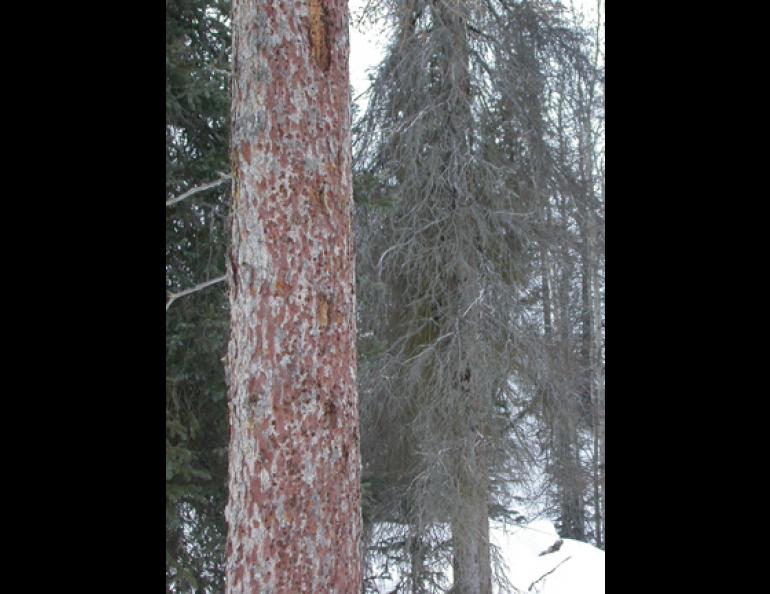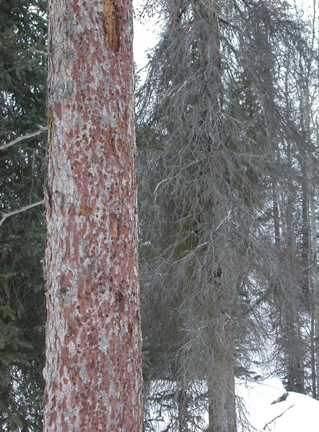
Bark beetles take Connecticut-size bite out of Alaska
An insect smaller than Ed Berg’s thumbnail uprooted he and his wife Sara.
Swarms of spruce bark beetles killed most of the centuries-old spruce trees surrounding the Bergs’ former home on East End Road in Homer in the late 1990s. After the beetles denuded their land, the Bergs moved into downtown Homer.
“Ninety-five percent of the trees on our two properties died,” Ed Berg said. “After we clearcut the dead trees so they wouldn’t fall on the house, we lost the privacy of the place because suddenly the house was visible from the road and we had all the road noise.”
Berg is an ecologist with the U.S. Fish and Wildlife Service office in Soldotna who recently attended a conference on the spruce bark beetle in Homer, where the bark beetle hit hardest during what many scientists call the worst outbreak in North America’s history. A few dozen scientists met on the Homer Spit to share their findings on the tiny creature that has changed the landscape of the Kenai Peninsula and much of southcentral Alaska, including the Anchorage area and the Copper River basin.
Berg presented a study in which he compared beetle outbreaks on the Kenai Peninsula to those in the Yukon Territory near Kluane National Park. He found that spruce bark beetles attacked white and Lutz spruce (a hybrid between white and Sitka spruce), and to a lesser degree Sitka spruce, an average of every 50 years on the Kenai Peninsula.
Beetles are nothing new; Berg pointed out that in 1899 members of the Harriman Expedition had described large patches of dead trees on the southern end of the Kenai Peninsula, and trees preserved in the soil of a Fairbanks hillside show that the beetles were in the Interior thousands of years ago. Though beetles have long attacked the spruce of Alaska, the latest outbreak was Biblical in scale. Why?
A long run of warmer temperatures, Berg said. Though the Kenai Peninsula has experienced warm summers many times during the past century, the warmth “really shifted into overdrive” from 1987 to 1997. Without cool, wet summers to knock down bark beetle populations, millions of beetles flew from tree to tree each spring, boring into the bark of spruce trees and laying eggs. When the eggs hatched, larvae grubs girdled the trees from within by feeding on the sugary inner bark, known as phloem. The result was an area the size of Connecticut in which spruce trees died en masse, giving the forest ecosystem a makeover from which it won’t soon recover. Now, most of the beetles are gone, but not because things have cooled down.
“Conditions are still warm here, but they’ve eaten themselves out of house and home,” Berg said.
Bark beetles have eaten Alaska spruce for centuries, but the recent outbreak was of a magnitude so large that forest managers at the conference agreed they could do little but watch and salvage dead trees for wood chips or firewood.
Though the bark beetles ravaged the Kenai Peninsula and southcentral Alaska, the forests there are not devoid of spruce trees; the beetles chose larger, older trees, and did not kill younger, pole-sized spruce. Those smaller trees are now benefiting from the lack of competition, and mature spruce forests will someday return, Berg said, as will the spruce bark beetle.
A lesson to remember is that after two or more consecutive warm summers, bark beetles on the Kenai Peninsula attacked in large numbers, Berg said. Knowing that, forest managers might be able to anticipate an outbreak and plan tree harvests ahead of the beetles or try preventative measures that might work on small outbreaks, such as tree thinning, pruning, setting out hormone traps for beetles, and getting rid of piles of logs that attract beetles.





